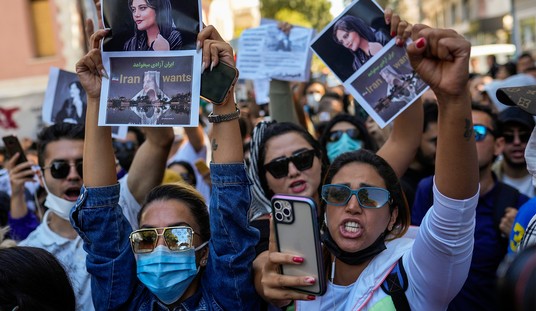Accounts of the Muslim Brotherhood’s torture chambers in Egypt raise one of history’s most daunting questions. Why is evil seemingly unkillable? The scenes of torment might with variations be from the previous Egyptian regime. Indeed they might be from any torture chamber anytime in history. The initial beatings; the screenings, the offer of false hope and finally the process of breaking the prisoner’s will. It is all the same. Mubarak — Morsi– Mubarak. The faces have changed yet the story remains the same.
Timothy Snyder, the author of the book Bloodlands, makes the case that two evils in opposition do not always cancel each other out. In fact evils in close proximity can stoke each other’s infernal fires. His account of the dire fate of populations caught between the German border and European Russia over whom both Nazi Germany and the Soviet Union fought over to kill illustrates the point with great effect. And it makes one wonder whether things in the Middle East are as simple as arming one against the other if both sides are malevolent.
But the idea of inescapable tragedy, or sorrow without redemption; the notion that our chosen allies may be as bad as our hated foes is too depressing for public consumption. People need a Black and White story to explain the sacrifices they are asked to make. Hence we made wartime heroes of the Soviet Union even as we have made democrats of the Muslim Brotherhood.
The truth was that the Nazis and Soviets needed each other in the same way that Arab Strongmen and the Jihad are complementary. When in conflict they kill more than each other. They destroy whatever else is in the way.
Only when Nazi Germany invaded Poland in 1939 and the Soviet Union in 1941 did Hitler’s visions of the elimination of the Jews from Europe intersect with the two most significant populations of European Jews … the bloodlands were where most of Europe’s Jews lived, where Hitler and Stalin’s imperial plans overlapped, where the Wehrmacht and the Red Army fought and where the Soviet NKVD and the German SS concentrated their forces … the deadliest part of the Soviet Union was its non-Russian periphery, and Nazis killed beyond Germany …
The tremendous majority of the mortal victims of both the German and Soviet regimes never saw a concentration camp … American and British forces reached none of the bloodlands and saw none of the major killing sites. It is not just that Americans and British forces saw none of the places where the Soviets killed … they never saw the places where the Germans killed, meaning that the understanding of Hitler’s crimes has taken just as long. The … German concentration camps were the closest that most westerners ever came to perceiving the mass killing … they were only hints at the history of the bloodlands. They are not the whole story; sadly, they are not even an introduction.
Without Molotov-Ribbentrop, absent the showdown between the monsters, the Bloodlands might not have have happened. It ironic that of history’s commentators, it is the Bolsheviks who understood most clearly the compansionship of evil. They felt it beside them and were not shy about acknowledging its presence.
Donald Rayfield, in his book Stalin and his Hangmen notes Yuri Andropov’s skepticism of Lord Acton’s maxim that “power corrupts and absolute power corrupts absolutely”. Andropov wryly said that only a “moron in his cups” could believe that. “Power is in fact corrupted by the people,” he concluded. We have ruined the world. It is not the world that has ruined us.
The presence of evil on both sides of an historical struggle makes it hard to manufacture a happy ending. It shatters the easy narrative of “Egyptian protesters” vs the authoritarian Mubarak regime; it spoils the easy fiction of the gallant Libyan rebels against Mohammar Khadaffy. It makes everything complicated. If the Obama administration is even now having second thoughts about letting Assad’s chemical weapons fall into the hands of the Free Syrian Army, it is only because it must realize that the weapons in those hands would not be such an improvement after all.
The New York Times now reports that Morsi may be preparing to declare Martial Law and Spengler at PJ Media makes the convincing case that Egypt’s economy is breaking down. The Four Horsemen have started a rodeo down in the Middle East and the Hope and Change Ringmaster can’t seem to find a way to get them out of the arena.
But maybe these Four Horsemen were never completely banished from history’s stage. We merely staged a funeral for civilizational evil after the Second World War, but there was in fact no one in the coffin. Hitler, maybe; but not the Soviets at any rate. We simply redefined the narrative and walked on. As Donald Rayfield reminds us, one of the two muderous regimes was never brought to account. The leaders of the Soviet Union “died in their beds … they died uncontrite”.
The guilty were, by and large, not brought to account nor even removed from power. Vladimir Putin’s Russia has rejoined the world community but it does not so much as deny as set aside Stalin’s holocaust …nobody in German smokes ‘Auschwitz’ cigarettes but Belomorkanal cigarettes, commemorating a camp where 100,000 were exterminated, are still sold in Russia.
The line from the Bloodlands still runs from Poland to Aleppo, as from Russia to Syria. Snyder describes the multitude of forgotten ghosts from the Bloodlands. They are so numerous we can scarcely believe they can exist. He notes:
In the middle of Europe in the middle of the 20th century, the Nazi and Soviet regimes murdered some fourteen million people. … The Nazi and Soviet regimes turned people into numbers … Fourteen million, after all, is a very large number. It exceeds by more than ten million the number of people who died in all of the Soviet and German concentration camps (as opposed to the death facilities) taken together over the entire history of both the Soviet Union and Nazi Germany … it exceeds by more than two million the number of German and Soviet soldiers, taken together, killed on the battlefield in the Second World War … it exceeds by more than thirteen million the number of American and British casualties, taken together, of the Second World War. It also exceeds by more than thirteen million all the American battlefield losses in all of the foreign wars that the United States has ever fought.
And so perhaps in self defense we have taken to laughing about them rather than acknowledging their presence. We make up tropes about rebels, the better to avoid the question of discriminating between the factions among them.
Martin Amis, before writing his book Koba the Dread: Laughter and the Twenty Million found himself laughing when his friend Christopher Hitchens made a semi-sarcastic reference to “old comrades”. Amis posed the question of why Hitler ‘elicits spontaneous fury and the other [Stalin, “Bolshevism”] elicits spontaneous laughter'”. He wrote the book to remind himself that Stalin’s crimes were real; that we couldn’t joke our way out of it simply to conceal the fact that the narrative we bought at so great a price was false.
It was self-mocking fondness for an old hope, an aid to forgetting the 20 million. But it was also the chasm between the nobility of the hope, the splendour of the propaganda about achievement, and the squalor of the reality.
The squalid reality is that there was no escape from responsibility, no solace in pretended idealism. The world can be amended but only if we take it for what it is. The Four Horsemen can never be seen off while the Ringmaster is himself a huckster; it cannot be evicted by lies; denial or snake oil. They can only be handled by facing the facts. Mubarak was a dictator. Alas, so too might be Morsi.
The Three Conjectures at Amazon Kindle for $1.99
Storming the Castle at Amazon Kindle for $3.99









Join the conversation as a VIP Member